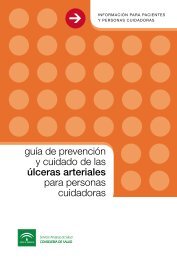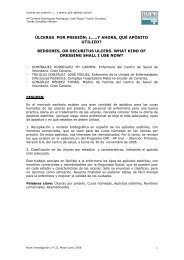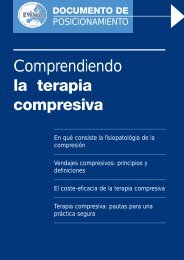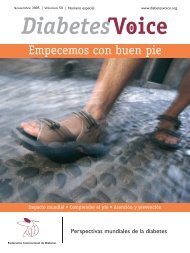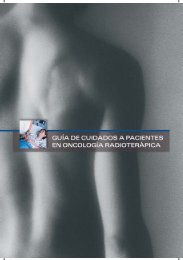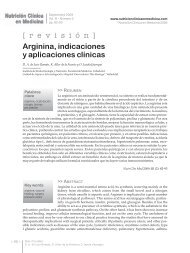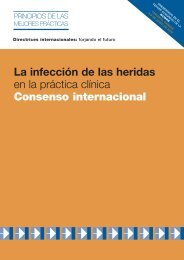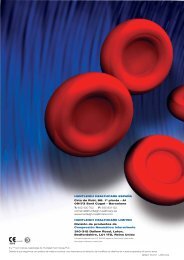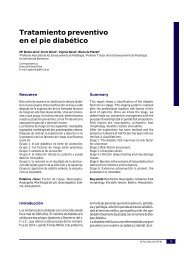Descargar - Úlceras.net
Descargar - Úlceras.net
Descargar - Úlceras.net
- No tags were found...
You also want an ePaper? Increase the reach of your titles
YUMPU automatically turns print PDFs into web optimized ePapers that Google loves.
84 ■ PIE DIABÉTICOlevels (13-14). The greater saphenous vein(GSV) is the most readily available anddurable conduit. Assessment of vein availabilityand quality is critical and should be carriedout by duplex mapping, before embarking onthe operation (15). Considerable debate hassurrounded the selection of alternative conduitsin the case of absence of the greatersaphenous vein (16).GRAFT AND TECHNICAL CHOICESeveral alternatives have been reportedfor infrainguinal grafts:• In situ autologous GSV;• Reversed autologous saphenous vein;• Other veins;• Varicose veins;• PTFE;• Dacron;• Heparin Bonded PTFE;• Peculiar technical artifices;• Allograft and Xenograft;• Composite grafts;• Combined Endovascular approach.GREATER SAPHENOUS VEINAn adequate ipsilateral greater saphenousvein, when available, is the best material forarterial reconstruction (14). In the largestAmerican series (17) of above the knee (AK)(31%) and below the knee (BK) (69%) bypasswas reported a cumulative patency rate of91% at 1 year, 81% at 5 years, and 70% at 10years. The in-situ technique was used in 75%of cases with a 90% of limb salvage at 10years. Also a European randomized prospectivestudy, with 75% of BK and 97% of CLIpatients, reported at 10 years a 41.7% primarypatency, a secondary patency of 64.8%, anda limb salvage of 73.5% (6).The in-situ technique was firstly used byMay e Rob in 1960s, then for several years itwas dismissed because of the technical pro -blems related to the valves disruption, untilLeather improved the method of the veinvalvulotomy (18). The advantages of thismethod are:• Caliper of the conduit decreasing progressively,thus improving hemodynamicand congruency of the anastomosis;• Preservation of adventitial vascularization;• Absence of wall trauma, which canoccur in the ex-situ technique.An alternative use is represented by thenon-reversed technique. This method consistsin the excision of the best available segmentof vein, valvulotomy and anastomosis (19). Theadvantage should be the use of the best segmentof the vein, the possibility to perform adifferent way functional to the necessity, andto perform the proximal anastomosis at differentlevel.This technique presented an increase riskof lesion of the collateral veins (20).In all this techniques it is fundamental toavoid skin necrosis secondary to an inappropriatepreparation and sampling of the vein.The echo-duplex mapping of the vein is consideredto be mandatory.OTHER VEINSWhen an adequate length of GSV is notavailable, different autologous materials canbe used, as lesser saphenous vein (LSV),cephalic and basilic arm veins, and remnantsof the GSV.The incidence of the absence of an adequateipsilateral GSV has been reported to beas high as 40 to 45%. The absence or the nonoptimalquality of this conduit is due to previoustreatment of varicose veins, its use in aprevious bypass (e.g., coronary bypass), aninsufficient diameter, or the presence of varicosedilatation.The lesser saphenous vein may representthe best alternative, with cumulative patencyrate and limb salvage similar to the GSV (21).Although harvesting the LSV may requireplacement of the patient in the prone positionwith subsequent repositioning to the supineposition for performance of the bypass (22),





